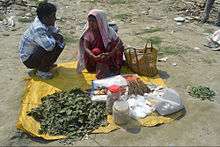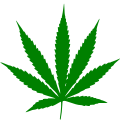Cannabis in India

Cannabis in India has been used since as early as 2000 BCE. All forms of cannabis are currently illegal in India, with some limited allowances made for some traditional preparations. In Indian society, common terms for cannabis preparations include charas (resin), ganja (flower), and bhang (seeds and leaves), with a milkshake made from bhang being one of the most common licit usages in India.
As of 2000, per the UNODC the "prevalence of abuse" of cannabis in India was 3.2%.[1]
Antiquity
Bhanga is mentioned in several Indian texts dated before 1000 CE. However, there is philological debate among Sanskrit scholars as to whether this bhanga can be identified with modern bhang or cannabis.[2]
Cannabis sativa is one of the candidates for the identity of the plant that was used to prepare soma in Vedic period.[3] Soma was an intoxicating ritual drink that has been highly praised in the Rigveda (c. 1700–1100 BCE).
Atharvaveda (c. 1500-1000 BCE) mentions bhanga as one of the five sacred plants that relieve anxiety. Sayana interpreted bhanga as a type of wild grass, but many scholars identify bhanga with cannabis.[4] The relevant verse:
To the five kingdoms of the plants which Soma rules as Lord we speak.
darbha, hemp, barley, mighty power: may these deliver us from woe,
The five kingdoms of plants, having Soma as their chief, we address;
the darbha, hemp, barley, saha — let them free us from distress.
Sushruta Samhita (c. 600 BCE) again mentions bhanga, as a medicinal plant, and recommends it for treating catarrh, phlegm and diarrhea.[2]
According to Gerrit Jan Meulenbeld and Dominik Wujastyk, Chikitsa-sara-sangraha (c. late 11th century) by Vangasena is the earliest extant Indian text that features an uncontested mention of cannabis. Vangasena mentions bhanga as an appetiser and a digestive, and suggests it in two recipes for a long and happy life. Narayan Sarma's Dhanvantariya Nighantu, a contemporary text, mentions a narcotic of the plant.[2]
Nagarjuna's Yogaratnamala (c. 12th-13th century) suggests that cannabis (mdtuldni) smoke can be used to make one's enemies feel possessed by spirits. Sharngadhara Samhita (13th century) also gives medicinal uses of cannabis, and along with ahiphena (opium poppy), mentions it as one of the drugs which act very quickly in the body.[2]
Cannabis also finds its mention in other historic scriptures like Dhanvantari Nighantu, Sarngandhara Samhita and Kayyadeva Nighantu. It is also referred in Ayurveda as an ingredient in various recipes of pain relievers and aphrodisiacs, but in small quantities. It is noted that large quantity or long time consumption can be addictive and that it is more dangerous than tobacco for lungs and liver.[7] Ayurveda however does not use cannabis for smoking recipes.[8]
The Hindu god Shiva is said to have chosen cannabis as his favorite food, after having spent one night sleeping under the plants leaves and when eating of it in the morning refreshed him. Another legend suggests that when the poison Halahala came out from the Samudra manthan, Shiva drank it to protect everyone from it. later, bhang was used to cool him down. Shiva Purana suggests offering bhang to Shiva during the summer months. But not all devotees offer bhang to Shiva.[9]
Many Ayurvedic texts mention cannabis as vijaya, while tantric texts mention it as samvid.[4]
British India
In 1894, the British Indian government completed a wide-ranging study of cannabis in India. The report's findings stated:
| “ | Viewing the subject generally, it may be added that the moderate use of these drugs is the rule, and that the excessive use is comparatively exceptional. The moderate use practically produces no ill effects. In all but the most exceptional cases, the injury from habitual moderate use is not appreciable. The excessive use may certainly be accepted as very injurious, though it must be admitted that in many excessive consumers the injury is not clearly marked. The injury done by the excessive use is, however, confined almost exclusively to the consumer himself; the effect on society is rarely appreciable. It has been the most striking feature in this inquiry to find how little the effects of hemp drugs have obtruded themselves on observation. | ” | |
| — Report of the Indian Hemp Drugs Commission, 1894-1895[10] | |||
Modern use

As bhang, cannabis is still popular in India.[11] It is also mixed in thandai, a milkshake-like preparation. Bhang is consumed as prasad of Lord Shiva, and is popular between Mahashivaratri and Holi (February–March).[12] Among Sikh Nihangs, bhang is popular, especially during Hola Mohalla.[13][14] Indian Sufis place the spirit of Khidr within the cannabis plant, and consume bhang.[15][16]
In Odisha, cannabis consumption is legal, and it is common to see people smoking chillums.[17]
Even in Assam, where bhang has been explicitly banned since 1958, it is consumed by thousands during the Ambubachi Mela. In 2015, the police did not stop devotees from consuming bhang, although they fined two people for smoking tobacco in public places, under the Cigarettes and Other Tobacco Products Act.[18]
Legal status

Attempts at criminalising cannabis in British India were made, and mooted, in 1838, 1871, and 1877.[19]
The 1961 international treaty Single Convention on Narcotic Drugs clubbed cannabis with hard drugs. During the negotiations, the Indian delegation opposed its intolerance to the social and religious customs of India. As a compromise, the Indian Government promised to limit the export of Indian hemp, and the final draft of the treaty defined cannabis as:[20]
"Cannabis" means the flowering or fruiting tops of the cannabis plant (excluding the seeds and leaves when not accompanied by the tops) from which the resin has not been extracted, by whatever name they may be designated.— Commentary on the Single Convention on Narcotic Drugs, 1961: Paragraph I, subparagrah (b).[21]
Bhang was thus left out from the definition of "cannabis". This allowed India to carry on the tradition of large-scale consumption of bhang during Holi. The treaty also gave India 25 years to clamp down on recreational drugs. Towards the end of this exemption period, the Indian government passed the Narcotic Drugs and Psychtotropic Substances Act in 1985.[22]
The NDPS maintained the same definition of "cannabis", excluding bhang from its purview:
"cannabis (hemp)" means:
(a) charas, that is, the separated resin, in whatever form, whether crude or purified, obtained from the cannabis plant and also includes concentrated preparation and resin known as hashish oil or liquid hashish;
(b) ganja, that is, the flowering or fruiting tops of the cannabis plant (excluding the seeds and leaves when not accompanied by the tops), by whatever name they may be known or designated; and(c) any mixture, with or without any neutral material, of any of the above forms of cannabis or any drink prepared therefrom;
— NDPS Act, 1985: I.2.iii[23]
NDPS banned the production and sale of cannabis resin and flowers, but permitted the use of the leaves and seeds, allowing the states to regulate the latter.[24]
In 2015, the first organised efforts to re-legalise cannabis in India appeared, with the holding of medical marijuana conferences in Bengaluru, Pune, Mumbai and Delhi by the Great Indian Legalisation Movement.[25]
Regional bans on bhang

Although NDPS allows consumption of bhang, various states have their own laws banning or restricting its use. In some states, only authorised dealers are allowed to sell bhang. Some states also have rules about the maximum amount of bhang one person can carry and the minimum age of the buyer.[26]
In Assam, The Assam Ganja and Bhang Prohibition Act, 1958, prohibits sale, purchase, possession and consumption of ganja and bhang.[27][18]
In Maharashtra, Section 66(1)(b) of the Bombay Prohibition (BP) Act, 1949, bans manufacture, possession and consumption of bhang and bhang-containing substances without a license.[28]
References
- ↑ Report of the International Narcotics Control Board (2008). DIANE Publishing. May 2009. pp. 90–. ISBN 978-1-4379-1361-3.
- 1 2 3 4 Ethan Russo (2006). Raphael Mechoulam, ed. Cannabis in India: ancient lore and modern medicine (PDF). Cannabinoids as Therapeutics. Springer. pp. 3–5. ISBN 9783764373580.
- ↑ Chris Bennett (2010). "Cannabis and the Soma Solution". Trine Day. ISBN 9781936296323.
- 1 2 Chris Conard (1997). Hemp for Health. Inner Traditions. pp. 43–44. ISBN 9780892815395.
- ↑ Hymns of the Atharva Veda, by Ralph T.H. Griffith, 1895
- ↑ William Dwight Whitney (1905). Atharva-Veda Saṃhitā, Volume 2. p. 438.
- ↑ Frawley, David (2012). Soma in Yoga and Ayurveda: The Power of Rejuvenation and Immortality. Lotus Press. p. 156. ISBN 0940676214. Retrieved 14 July 2015.
- ↑ Gilman, Sander L. (2004). Smoke: A Global History of Smoking. Reaktion Books. p. 74. ISBN 1861892004. Retrieved 14 July 2015.
- ↑ Tod Mikuriya (1994). Excerpts from the Indian Hemp Commission Report. Last Gasp. p. 38. ISBN 0867194200. Retrieved 13 July 2015.
- ↑ "(298) Page 264 - India Papers > Medicine - Drugs > Report of the Indian Hemp Drugs Commission, 1894-1895 > Volume I - Medical History of British India - National Library of Scotland". nls.uk. Retrieved 13 July 2015.
- ↑ Leslie L. Iversen (6 November 2007). The Science of Marijuana. Oxford University Press. pp. 18–. ISBN 978-0-19-979598-7.
- ↑ "Bhang, thandai market booms". The Times of India. 2014-02-27.
- ↑ Hola Mohalla: United colours of celebrations,
- ↑ "Mad About Words". Telegraphindia.com. 2004-01-03. Retrieved 2014-01-04.
- ↑ Lloyd Ridgeon (2006). Sufi Castigator: Ahmad Kasravi and the Iranian Mystical Tradition. Routledge. p. 30. ISBN 9781134373987.
- ↑ Michael Knight (2009). Journey to the End of Islam. Soft Skull. p. 28.
- ↑ Deeptiman Tiwary (2015-03-29). "Cannabis ban is elitist. It should go: Tathagata Satpathy".
- 1 2 Samudra Gupta Kashyap (2015-06-23). "Kamakhya ushers in annual festival, with annual cannabis problem".
- ↑ A Cannabis Reader: Global Issues and Local Experiences : Perspectives on Cannabis Controversies, Treatment and Regulation in Europe. European Monitoring Centre for Drugs and Drug Addiction. 2008. p. 100. ISBN 978-92-9168-311-6.
- ↑ Gabriel G. Nahas and Henry Clay Frick (2013). Drug Abuse in the Modern World: A Perspective for the Eighties. Elsevier. p. 262.
- ↑ Commentary on the Single Convention on Narcotic Drugs, 1961
- ↑ Manoj Mitta (2012-11-10). "Recreational use of marijuana: Of highs and laws". The Times of India.
- ↑ Narcotic Drugs and Psychotropic Substances Act (India). Chapter I, Section 2.iii
- ↑ Jonathan P. Caulkins; Angela Hawken; Beau Kilmer; Mark Kleiman (14 June 2012). Marijuana Legalization: What Everyone Needs to KnowRG. Oxford University Press. pp. 139–. ISBN 978-0-19-991372-5.
- ↑ "City to host country's first 'legalise marijuana' meet". Bangaloremirror. Retrieved 13 July 2015.
- ↑ Aditi Malhotra (2015-03-06). "Is it Legal to Get High on Bhang in India?".
- ↑ Assam Gania and Bhang Prohibition Act, 1958
- ↑ Vaibhav Ganjapure (2012-06-28). "'Bhang' is intoxicant, its possession is prohibited: HC". The Times of India.
| Wikimedia Commons has media related to Cannabis in India. |

